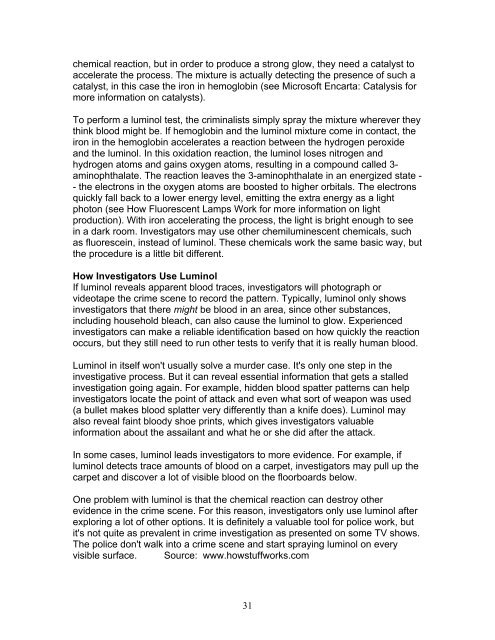Investigating CSI – Background material Table of Contents I ...
Investigating CSI – Background material Table of Contents I ...
Investigating CSI – Background material Table of Contents I ...
Create successful ePaper yourself
Turn your PDF publications into a flip-book with our unique Google optimized e-Paper software.
chemical reaction, but in order to produce a strong glow, they need a catalyst to<br />
accelerate the process. The mixture is actually detecting the presence <strong>of</strong> such a<br />
catalyst, in this case the iron in hemoglobin (see Micros<strong>of</strong>t Encarta: Catalysis for<br />
more information on catalysts).<br />
To perform a luminol test, the criminalists simply spray the mixture wherever they<br />
think blood might be. If hemoglobin and the luminol mixture come in contact, the<br />
iron in the hemoglobin accelerates a reaction between the hydrogen peroxide<br />
and the luminol. In this oxidation reaction, the luminol loses nitrogen and<br />
hydrogen atoms and gains oxygen atoms, resulting in a compound called 3aminophthalate.<br />
The reaction leaves the 3-aminophthalate in an energized state -<br />
- the electrons in the oxygen atoms are boosted to higher orbitals. The electrons<br />
quickly fall back to a lower energy level, emitting the extra energy as a light<br />
photon (see How Fluorescent Lamps Work for more information on light<br />
production). With iron accelerating the process, the light is bright enough to see<br />
in a dark room. Investigators may use other chemiluminescent chemicals, such<br />
as fluorescein, instead <strong>of</strong> luminol. These chemicals work the same basic way, but<br />
the procedure is a little bit different.<br />
How Investigators Use Luminol<br />
If luminol reveals apparent blood traces, investigators will photograph or<br />
videotape the crime scene to record the pattern. Typically, luminol only shows<br />
investigators that there might be blood in an area, since other substances,<br />
including household bleach, can also cause the luminol to glow. Experienced<br />
investigators can make a reliable identification based on how quickly the reaction<br />
occurs, but they still need to run other tests to verify that it is really human blood.<br />
Luminol in itself won't usually solve a murder case. It's only one step in the<br />
investigative process. But it can reveal essential information that gets a stalled<br />
investigation going again. For example, hidden blood spatter patterns can help<br />
investigators locate the point <strong>of</strong> attack and even what sort <strong>of</strong> weapon was used<br />
(a bullet makes blood splatter very differently than a knife does). Luminol may<br />
also reveal faint bloody shoe prints, which gives investigators valuable<br />
information about the assailant and what he or she did after the attack.<br />
In some cases, luminol leads investigators to more evidence. For example, if<br />
luminol detects trace amounts <strong>of</strong> blood on a carpet, investigators may pull up the<br />
carpet and discover a lot <strong>of</strong> visible blood on the floorboards below.<br />
One problem with luminol is that the chemical reaction can destroy other<br />
evidence in the crime scene. For this reason, investigators only use luminol after<br />
exploring a lot <strong>of</strong> other options. It is definitely a valuable tool for police work, but<br />
it's not quite as prevalent in crime investigation as presented on some TV shows.<br />
The police don't walk into a crime scene and start spraying luminol on every<br />
visible surface. Source: www.howstuffworks.com<br />
31


